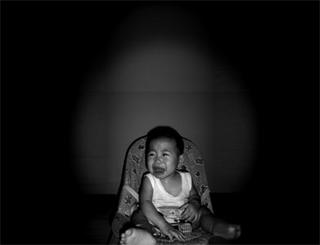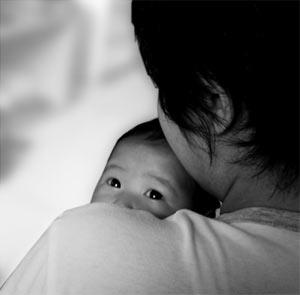Separation Anxiety
Monday, June 27, 2005
 Bwaaahhhhahhaaa.... please don't leeeavvee meee alllooonneeeeeeeee!!!!!!!!! Bwhhaa.. where r u guys??? Bwaahaha!!
Bwaaahhhhahhaaa.... please don't leeeavvee meee alllooonneeeeeeeee!!!!!!!!! Bwhhaa.. where r u guys??? Bwaahaha!!
For the first six months of her life, Arwen enjoyed the attention of new people, smiled at any friendly face and played around by herself.
Then she hit the 7-month mark, and everything changed. "If I made a move toward the door, she would start screaming. I was just racked with guilt every time I had to go somewhere without her."
Kebayang kan, kalo kita harus selalu ada di sampingnya terus, gak mau ditinggal sama sekali, even ke dapur atau kamar mandi. Whooaaaa!! Mamin jadi ikutan nangis :), gak berkutik di samping Arwen. Gak bisa ngapa-ngapain.
Arwen gak mau lagi bobok sendiri, apalagi ditinggal main sendiri, sementara Mamin melakukan aktifitas lain. Baru aja melangkah keluar pintu, Arwen udah teriak, kayak takut ditinggalin.
Awalnya Mamin bingung, kok Arwen jadi dikit-dikit nangis, tapi kalo ditinggalin aja. Ternyata setelah browsing sana-sini, Arwen mulai masuk masa-masa "Separation Anxiety."
Untungnya pernyataan di bawah ini (diambil dari www.parents.com), bisa membuat kami lega :
But as it turns out, separation anxiety is a normal part of his development. "During the first six months of her life, your baby has no idea that she is independent from her parents -- or any other caregiver," says Jude Cassidy, Ph.D., a professor of psychology at the University of Maryland, in College Park. That's why most young babies will happily move from one lap to another. It simply doesn't matter who provides the food or the love, as long as it's there.
At about 6 months, however, your baby begins to distinguish one person from another and starts forming strong emotional attachments to his parents and caregivers. He's also coming to understand the concept of object permanence: When his mother leaves the room, he remembers that she left and wonders when she'll return. "When you add these two developmental advances together, you've got the perfect equation for separation anxiety," Dr. Cassidy says.
In actuality, then, his sorrow at your departure is a positive sign. "It's an indication that a child is attached to his parents," says Ross A. Thompson, Ph.D., a professor of psychology at the University of Nebraska, in Lincoln. Ultimately, this strong sense of security will help your baby learn to be an independent toddler. In the meantime, here are a few strategies to help calm his anxiety.
1. Practice, Practice, Practice!
To make separation less of a shock, play peekaboo to help reinforce the point that you'll return even if she can't see you. You can also send stuffed animals or dolls on little "journeys" and then reunite them with your child.
2. Familiarity Breeds Comfort
If you take your baby to day care or on a visit to Grandma's, spend time acquainting him with his surroundings. When Diane Kreyer took her son to day care, she allowed a few extra minutes each day to play with Brett and his favorite toy. "Having this same routine made it more familiar to him and easier for me to leave," Kreyer says.
If it seems to help your baby, bring along a security object or two -- a blanket, a stuffed animal, a favorite toy. These items may provide her with a strong sense of safety and connection to home.
3. Getting to Know You
Before you leave your baby alone with a caregiver, make sure he is comfortable with that person. If, for example, a new baby-sitter is coming to your home for the evening, ask her to come over about an hour early and spend some time with your child before you leave the two of them alone together. That way, your child won't feel as if she's being left with a stranger. You may also want to let the sitter know about your child's favorite toys, games, and foods.
4. Rituals of Reassurance
Tempting as it may be to sneak away to avoid a teary scene, resist the urge. It will only undermine your child's sense of security. Instead, create a good-bye ritual that will soothe both of you. When her daughter, Caitlin, was 8 months old, Claire Hewitt developed a special good-bye wave to make her feel more secure. "I'd leave the house, and her baby-sitter would bring her to the window so we could wave at each other. It really helped her come to terms with my departure," says this mom from Manchester, New Hampshire.
5. For Crying Out Loud
It's normal -- and healthy -- for your baby to cry when you leave, so don't discourage it. "The ability to be aware of and express one's feelings is an important emotional foundation," Dr. Cassidy says. That does not mean, however, that you should delay departure. Hanging around trying to comfort him may only prolong the agony. Instead, give your child a hug and a kiss, tell him you love him, and hand him over to the caregiver. Soon enough, he'll stop crying -- and you'll stop feeling guilty.
6. Many Happy Returns
"As parents, we often overlook an important part of the separation process -- the reunion," Dr. Thompson says. "Happy reunion rituals are essential to reinforcing the parent-child bond and keeping separation anxiety in check." Dr. Thompson suggests following your child's cues. If she reaches up to you when you arrive, give her a big hug and just hang out with her a little while before heading back inside. If she waves a toy, get down and play with her for a few minutes. "These kinds of happy returns remind your child that no matter how sad it is when Mommy and Daddy leave," Dr. Thompson says, "it's always wonderful when they come back."
(original post)
0 comments:
Post a Comment